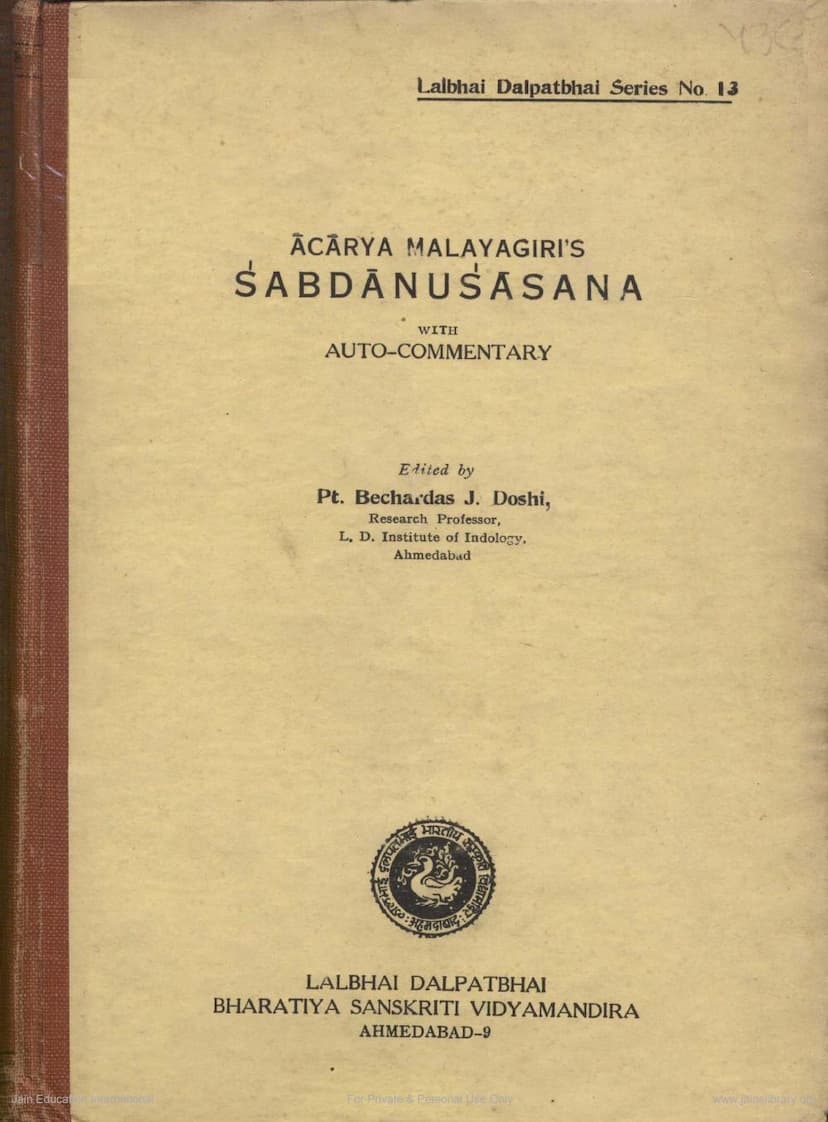Shabdanushasana
Added to library: September 2, 2025

Summary
This comprehensive summary focuses on the Śabdānuśāsana by Ācārya Malayagiri, edited by Pt. Bechardas Doshi, and published by L D Indology Ahmedabad. The text is a significant work on Jain grammar, offering a unique perspective within the broader field of Sanskrit linguistics, particularly from a Jain philosophical viewpoint.
Here'I'll provide a summary based on the structure and content indicated in the provided pages:
Book Title: Śabdānuśāsana Author: Ācārya Malayagiri Auto-commentary: Included (implied by "SABDĀNUSASANA WITH AUTO-COMMENTARY" on page 1) Editor: Pt. Bechardas J. Doshi Publisher: L D Institute of Indology, Ahmedabad Series: Lalbhai Dalpatbhai Series No. 13 First Edition: March 1967 (500 copies)
Overall Summary:
The Śabdānuśāsana by Ācārya Malayagiri is a crucial work in the field of Jain grammar, offering a systematic analysis of the Sanskrit language from a Jain perspective. Edited critically by Pt. Bechardas Doshi, this volume brings to light an otherwise unpublished work, greatly enhancing comparative studies of various Sanskrit grammars. The text is noted for its extensive commentaries (vṛttis) that not only explain grammatical rules but also engage in philosophical and logical discussions, often refuting opposing viewpoints. Malayagiri's work is characterized by its unique grammatical framework, its detailed exploration of sandhi, nominal declensions (nāmni), verbal conjugations (ākhyāte), derivative formations (kṛdante), and suffixes (taddhite). The introduction by Dalsukh Malvania highlights Malayagiri's likely contemporary relationship with Acārya Hemacandra and his deep scholarship, evident in his meticulous explanations and borrowing of linguistic elements from local dialects. The inclusion of various appendices, such as comparative tables of grammatical rules and lists of used sources, further adds to the scholarly value of this edition.
Key Aspects and Content Breakdown:
-
Authorship and Editing:
- Author: Ācārya Malayagiri, a distinguished Jain scholar. His work is considered significant among the grammars composed by Jain ācāryas, alongside Jainendra, Śākaṭāyana, and Hemacandra.
- Editor: Pt. Bechardas J. Doshi, a renowned scholar in Sanskrit grammar, is praised for his critical edition, which enhances the work's value through a learned introduction and important appendices.
- Publisher: L D Institute of Indology, Ahmedabad, as part of the Lalbhai Dalpatbhai Series, indicating a focus on preserving and publishing rare Indological texts.
-
Historical Context and Malayagiri's Life:
- Malayagiri is identified as a contemporary of Ācārya Hemacandra, likely living in the first half of the 13th century V.E. (circa 1227 V.S.).
- His philosophical stance is evident in his commentaries, where he refutes theories like those of the saṃsāramocakas and criticizes anātmavāda and vijñānavāda.
- His linguistic origins are suggested to be Saurāṣṭra, based on the sanskritized Gujarati words found in his commentaries. He likely toured extensively in Lāṭa and Saurāṣṭra.
-
Structure and Substance of Śabdānuśāsana:
- The grammar is divided into pādas (sections), but not into adhyāyas (chapters) like Pāṇini's grammar.
- The text covers the following major topics:
- Sandhi (First Five Pādas): Deals with phonetic changes and combinations of sounds, covering svara sandhi (vowel changes) and vyañjana sandhi (consonant changes). The first pāda focuses on saṃjñās (technical terms).
- Nāmni (Next Nine Pādas): Covers nominal forms, including gender marking (stripratyaya), case relations (kāraka), and compounds (samāsa).
- Ākhyāta (Ten Pādas): Focuses on verbal forms and conjugations.
- Kṛdante (Six Pādas): Deals with derivative suffixes forming nouns from verbs.
- Taddhite (Twelve Pādas, of which Six are Extant): Covers derived suffixes added to nouns.
-
Grammatical Innovations and Peculiarities:
- Malayagiri's grammar is compared to other prominent Sanskrit grammars like Pāṇiniya, Kāśikā, Candra, Jainendra, Śākaṭāyana, and Siddha-Hema.
- He accepts saṃjñās like svara, vyañjana, etc., and also invents his own, such as svasaṃjñā, mit, etc.
- His structure deviates from Pāṇini's by not using adhyāyas and organizing topics differently.
- He shows a strong adherence to Jain scriptures, harmonizing scriptural views with reason when conflicts arise.
- His commentaries (vṛttis) are extensive, sometimes reaching five hundred verses for a single verse, indicating a thorough treatment of topics.
- He often quotes previous ācāryas and Sanskrit/Prakrit lexicons to support his explanations.
- Malayagiri's grammar is noted for its brevity compared to Pāṇini and Hemacandra in terms of the number of sūtras, but this brevity is compensated by numerous vārtikas, nipāta-sūtras, and gaṇa-sūtras. He also leaves some usages unexplained, suggesting the loss of parts of his work.
-
Notable References and Influences:
- Malayagiri respectfully quotes Ācārya Hemacandra, suggesting Hemacandra's earlier influence.
- He refers to Śākaṭāyana as a paramount grammarian, quoting him frequently.
- He also mentions Candragomin, the author of Cāndravyākaraṇa.
- The grammar itself is referred to by name in Malayagiri's commentaries on the Sūryaprajñapti and Prajñāpanā.
- The catalogue Bhaṭṭi tippanikā mentions Malayagiri's work under the name Muṣṭivyākaraṇa.
-
Substance of the Grammar (as per table of contents and introduction):
- Sandhi: Covers rules for vowel and consonant changes, including specific rules for assimilation and modification based on context and sound.
- Nāmni: Details the formation of nouns, including gender agreement, case marking (vibhakti), kāraka rules, and samāsa (compounding).
- Ākhyāte: Explains the conjugation of verbs, tenses, moods, and voices.
- Kṛdante: Discusses the formation of nominal and verbal derivatives using various suffixes.
- Taddhite: Details suffixes added to nominal stems to form new nouns or adjectives, covering a wide range of semantic and phonetic rules.
-
Editorial Contribution:
- Pt. Bechardas J. Doshi's work involved preparing the final copy, marking different divisions of composition (sūtra, vṛtti, udāharaṇa), correcting text based on other grammars, and restoring minor missing portions. He acknowledges the extensive corruption in the manuscripts, making the restoration task arduous.
- The preface expresses gratitude to Muni Shri Punyavijayaji for providing the necessary manuscript material.
In essence, the Śabdānuśāsana is presented as a comprehensive and scholarly grammatical treatise, critical for understanding the evolution of Sanskrit grammar and its specific development within the Jain tradition. Malayagiri's work is recognized for its detailed explanations, philosophical insights, and its place in the lineage of Indian grammatical traditions.